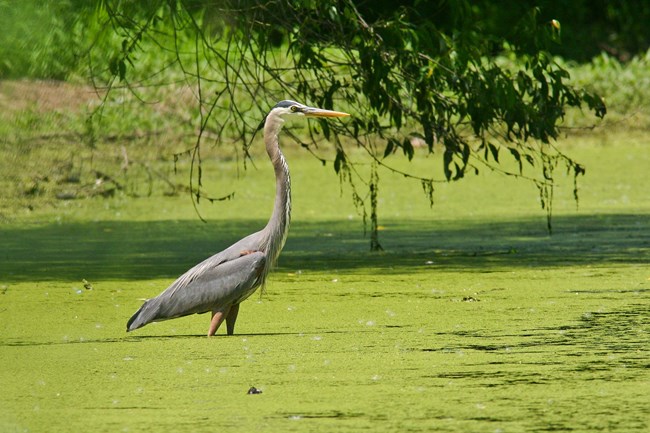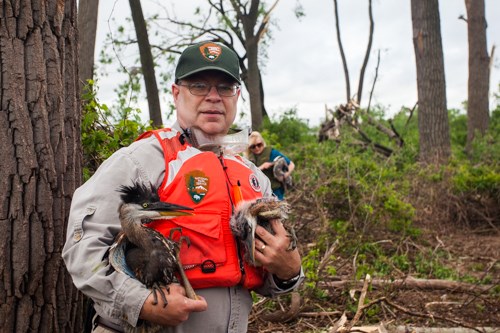
NPS/Gordon Dietzman IntroductionThe charismatic great blue heron, at about four feet in height and a wingspan of about six feet, is the largest heron in North America. This bluish-gray, long-legged wader is a common resident of the Mississippi National River and Recreation Area, where it can be seen stalking prey along the river and the edges of shallow floodplain lakes. The blue heron is well suited to finding and catching fish. A patient hunter, the blue heron hunts by wading slowly in shallow water where it finds crayfish, fish, small turtles, leeches, aquatic insects, and frogs. Its bill is pointed and serrated, which makes it well suited to stab and grip its slippery prey. It may also hunt for small animals, such as mice, and large insects in grasslands and fields. Great blue herons nest in treetop "colonies," sometimes also called "heronries." Colonies may consist of a few nests but some are much larger. Nests are generally located 30-70 feet above the ground or water in large trees, which often stand in water or on an island. Such a location may reduce nest predation by land-based predators. Nesting in colonies also increases the number of sharp eyes looking for dangerous predators. There is a white color phase of the blue heron called a "great white heron," but it's range is limited to Florida and it isn't found in Minnesota. If you spot a large, heron-like bird that is white in the park, it is most likely a great egret. 
Wildlife and WeatherOn the afternoon of May 22, 2011, a tornado ripped its way across North Minneapolis destroying homes and businesses and killing one person while injuring 30 others. It's path carried it through the Mississippi National River and Recreation Area and across an in-river island containing a large colony of breeding blue herons at the height of the nesting season. The large trees and the nests were destroyed dumping chicks and eggs onto the island and into the river and killing and injuring adult birds. Park rangers from the Mississippi National River and Recreation Area, wildlife rehabilitation experts, and a Minnesota conservation officer visited the island rescuing heron chicks and injured adult birds. Severe weather affects wildlife as well as people. In this case direct effects included the destruction of individual adults and chicks through the high winds that threw the birds into trees or drove high-velocity debris into the birds. Chicks fell from the treetops as nests disintegrated. Even more importantly, winds destroyed the trees that made up the nesting habitat of this particular colony. Some of the surviving birds established a new colony downriver on another wooded island at Marshall Terrace Park while others joined a pre-existing colony upriver at Coon Rapids Dam Regional Park. The island, its trees bent and broken, has failed to host its own colony of these fascinating birds since that violent day. Fascinating Facts
Identification
Find ThemThese stately birds are common and may be found along the Mississippi and Minnesota Rivers within the park. Load a map of recent sightings within our park. There is a rookery on an island just upstream from Marshall Terrace Park and another at Pig's Eye lake. The Pig's Eye lake rookery is closed to visitation during the nesting season to prevent disturbance to chicks and nesting adults. Please do not approach. You Can HelpLearn about our Citizen Science projects. Our projects are not only challenging, but fun as well. Plus you will contribute to our knowledge about the park. | |
Last updated: August 7, 2018
